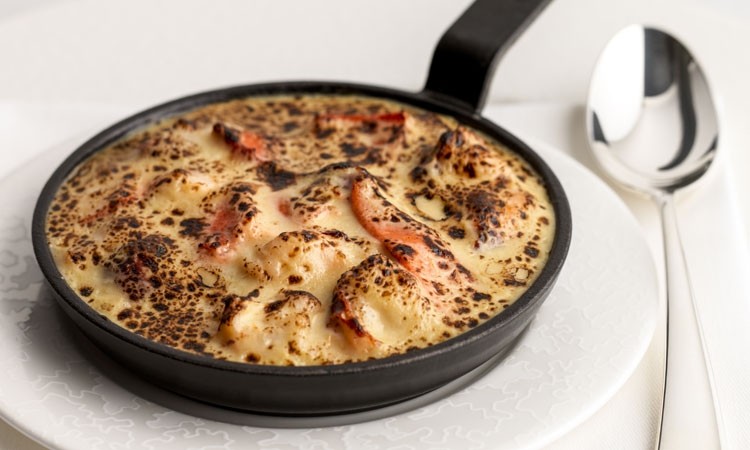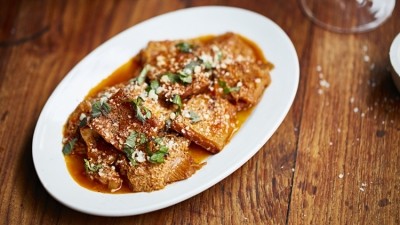Chef Masterclass: Lobster thermidor omelette by Tom Kerridge and Nick Beardshaw

There are several plausible theories surrounding the creation of lobster thermidor, but none of them concerns either Napoleon or Auguste Escoffier. Thermidor was one of the summer months in the French Revolutionary calendar, and some claim Napoleon named the dish after the month in which he first sampled it. Since no recipe appears until nearly a century later, however, this seems unconvincing.
And, while Wikipedia confidently states that the dish was invented by Escoffier around 1880, this too is unlikely. It was almost certainly named after a play: Thermidor (by French dramatist Victorien Sardou: eggs Sardou, the great Louisiana Creole dish of eggs, artichoke, spinach and hollandaise, was named in honour of his visit to New Orleans) was staged at the Comédie Française in 1891, and the famous Café de Paris created a dish to capitalise on the play’s anticipated success.
Whether it was first cooked by head chef Léopold Mourier or by his sous-chef Tony Giraud is uncertain, but the basic idea – lobster cooked, then chopped, mixed with a mustard-rich cream sauce, put back in its shell, sprinkled with cheese and grilled until bubbling – has persisted as one of the most unashamedly luxurious dishes in French cuisine. However, lobster thermidor is really just a rebranded variation on a common theme: a recipe for Dr Hunter’s stuffed lobster was published in England in 1804, for example, featuring lobster and béchamel topped with butter and breadcrumbs.
Chefs continue to interpret thermidor in their own way to this day. At Kerridge’s Bar and Grill, head chef Nick Beardshaw turns it into an omelette, rather like a classic omelette Arnold Bennett but with lobster instead of smoked haddock. Priced at £34.50 (well, it does contain a whole lobster), his version dispenses with the shell for serving purposes – he uses small Staub frying pans – but the rich sauce that acts as a glaze is fortified with oil infused with the lobster’s shell.
Beardshaw first kills the lobster humanely – “put it in the freezer to go sleepy for 20 minutes, then find the cross just at the back of the lobster’s head and sever it with a knife, which will cut the main nerve and ensure an instant, painless death” – then cooks it in heavily salted water. “It should taste like the sea. And don’t overcook the lobster: it can still be slightly under at this point.” He then chops the flesh and gently cooks the shell and trimmings in oil, at a confit temperature, to get maximum flavour for his glaze.
The omelette can also be slightly undercooked. Beardshaw then spreads the cheese and lobster over the surface, glazes the dish with his egg-enriched sauce and finishes it
with a blowtorch until it bubbles and browns. “It serves one as a decadent starter, or you can have it with chips as a main course.”
However you cook lobster thermidor – and there are myriad variations – it is a dish that has a rich history and a secure future, unlike Sardou’s play. Beset by angry protests from revolutionary sympathisers, Thermidor lasted just three performances.
Ingredients (makes one omelette)
1 live lobster, 600g to 800g
250ml sunflower oil
300ml milk
1 clove
2 bay leaves
10 black peppercorns
30g butter
30g plain flour
3 egg yolks
50g English mustard
3 whole eggs (Burford Browns, for preference)
Butter for frying
30g Parmigiano Reggiano
Method
1. Put the lobster into the freezer for 20 mins, then pierce the cross on the top of its head with the point of a chef’s knife to sever the main nerve. Break off the tails and claws and keep the rest of the lobster to one side for making oil. Cook the tails and claws in a pan of simmering salted water for 3 minutes. Remove the lobster and put into iced water.
2. Using the back of a chef’s knife, crack open the claws and tail, and remove the meat. Remove the green vein that runs along the back of the lobster tail. Dice all the meat into 1.5cm squares and set aside. You should have around 140g of meat.
3. Put the shells from the claws, tail and the rest of the body into a pan with the oil. Cook on a low heat for 2 hours, stirring occasionally, ensuring the shells stay submerged. Strain the oil and keep it warm.
4. To make the béchamel, bring the milk to the boil with the clove, bay leaves and peppercorns. Remove from the heat and let it infuse for 10 minutes. Melt the butter over a medium heat, then add the flour and cook for one minute, stirring all the time. Strain the infused milk and whisk in a little at a time until the sauce is silky and smooth. Cook gently for 15 minutes over a low heat.
5. Take off the heat and stir in 100ml of the lobster oil, the egg yolks and the mustard. The sauce should be the consistency of single cream: let it down with a little milk if necessary. Season and keep warm until ready
to use.
6. To make the omelette, crack the eggs into a bowl and whisk. Warm a small iron skillet over a medium heat with a knob of butter. Turn up the heat until the butter just starts to sizzle, add the egg and cook gently, using a spatula to form it into a classic omelette. Remove from the heat.
7. While the egg is cooking, gently warm the lobster under a grill or in a medium oven, taking care not to overcook it. Season with salt and white pepper. Grate the Parmigiano onto the egg, then top with the warm lobster. Spread the glaze over the lobster so that it covers it completely and reaches the edges of the pan. Use a blowtorch to caramelise the top of the omelette. Serve immediately.
This is a web version of an article that first appeared in the July issue of Restaurant magazine, the leading title for the UK's restaurant industry. For more features, comment, interviews and in-depth analysis of the restaurant sector subscribe to Restaurant magazine here.
















